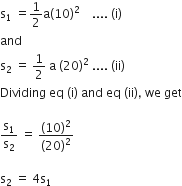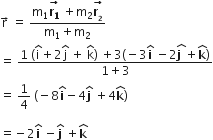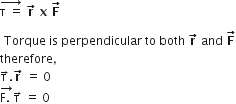A particle starts its motion from rest under the action of a constant force. If the distance covered in first 10 s is s1 and that covered in the first 20 s is s2, then
s2 = 2s1
s2 = 3s1
s2 = 4 s1
s2 = 4 s1
C.
s2 = 4 s1
If the particle is moving in a straight line under the action of a constant force then distance covered s = ut + at2 /2
since the body start from rest u = 0
therefore, s = at2/2
Now,
Two bodies of mass 1 kg have position vectors, respectively.The centre of mass of this system has a position vector
respectively.The centre of mass of this system has a position vector




B.

The position vector of centre of mass
Point to know:
The centre of mass changes its position only under the translatory motion. There is no effect of rotatory motion on centre of mass of the body.
If  is the force acting on a particle having position vector
is the force acting on a particle having position vector  be the the torque of this force about the origin, then
be the the torque of this force about the origin, then




C.

Torque is an axial vector ie, its direction is always perpendicular to the plane containing vectors 

The distance travelled by a particle starting from rest and moving with an acceleration 4/3 ms-2 in the third second is
6 m
4 m
10/3
10/3
C.
10/3
Distance travelled by the particle in nth second
Where u is initial speed and a is an acceleration of the particle.
Here, n = 3, u =0, a = 4/3 m/s2
